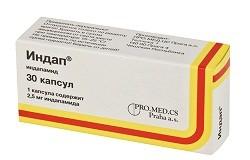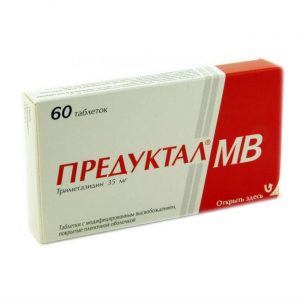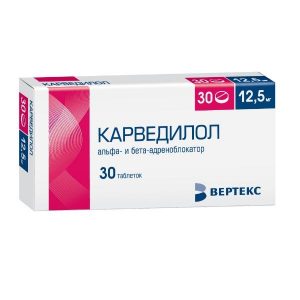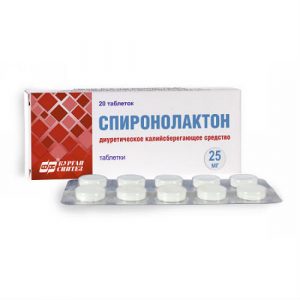Description
Packing
30 pcs
Indications
Arterial hypertension sodium and water retention in chronic heart failure.
Contraindications
hypersensitivity to indapamide, other sulfonamide derivatives and components of the drug
severe cerebrovascular accident
severe hepatic impairment (including encephalopathy) and / or renal failure, anuria sremlpremk QT interval prolonging
lactose intolerance, galactosemia, glucose malabsorption syndrome,
galactose pregnancy and
lactation period under 18 years of age (efficacy and safety not established).
Caution: diabetes mellitus in the stage of decompensation hyperuricemia (especially accompanied by gout and urinary nephrolithiasis) hyponatremia and other disorders of water-electrolyte metabolism moderate hepatic and / or renal failure ascites ischemic heart disease chronic heart failure prolongation of the QT interval hyperparathyroidism.
Special instructions
When prescribing the drug to patients taking cardiac glycosides, laxatives against hyperaldosteronism, as well as elderly people, regular monitoring of the content of potassium ions and creatinine levels is indicated.
While taking indapamide, the concentration of potassium, sodium, magnesium ions in the blood plasma (electrolyte disturbances can develop), pH, the concentration of glucose, uric acid and residual nitrogen should be systematically monitored.
The most careful control is indicated for patients with cirrhosis of the liver (especially with edema or ascites due to the risk of developing metabolic alkalosis, which increases the manifestations of hepatic encephalopathy), as well as with coronary artery disease, heart failure and the elderly. An increased risk group also includes patients with an increased QT interval on the ECG (congenital or developing against the background of any pathological process). The first determination of the concentration of potassium ions in the blood should be carried out during the first week of the drug.
Hypercalcemia with indapamide may be due to previously undiagnosed hyperparathyroidism.
In patients with diabetes, it is extremely important to control the level of glucose in the blood, especially in the presence of hypokalemia.
Significant dehydration can lead to the development of acute renal failure (decreased glomerular filtration). Patients need to compensate for water loss and carefully monitor renal function at the beginning of treatment.
Indapamide can give a positive result when conducting a doping control.
Patients with arterial hypertension and hyponatremia (due to taking diuretics) need to stop taking diuretics 3 days before taking ACE inhibitors (if necessary, diuretics can be resumed somewhat later), or ACE inhibitors are prescribed in low initial doses.
When prescribing indapamide, it must be borne in mind that sulfonamide derivatives can exacerbate the course of systemic lupus erythematosus.
Dosage and administration
Inside, in the morning, regardless of food intake, a capsule is swallowed without chewing, washed down with water. Assign 2.5 mg / day (1 capsule).
The drug can be used as monotherapy or in combination with other antihypertensive agents (? -adrenoblockers, BKK, ACE inhibitors). If after 4-8 weeks of treatment the desired therapeutic effect is not achieved, it is not recommended to increase the dose of the drug (the risk of side effects without increasing the antihypertensive effect increases). Instead, it s advisable to add another antihypertensive drug to the treatment regimen, not a diuretic. In cases where treatment must be started with 2 drugs, the dose of Indap ® remains 2.5 mg / day in the morning.
Dosage and administration of
The drug is administered orally, regardless of food intake.
With monotherapy, the recommended dose of saxagliptin is 5 mg 1 time / day.
In combination therapy, the recommended dose of saxagliptin is 5 mg 1 time / day in combination with metformin, thiazolidinediones or sulfonylureas.
When starting combination therapy with metformin, the recommended dose of saxagliptin is 5 mg 1 time / day, the initial dose of metformin is 500 mg / day. In case of an inadequate response, the dose of metformin may be increased.
If you skip taking Ongliz ®, you should take the missed tablet as soon as the patient remembers this, but you should not take a double dose of the drug for one day.
Dose adjustment is not required for patients with mild renal insufficiency (CC> 50 ml / min). For patients with moderate or severe renal failure (CC ¥ 50 ml / min), as well as for patients undergoing hemodialysis, the recommended dose of Ongliz ® is 2.5 mg 1 time / day. The drug should be taken at the end of a hemodialysis session. The use of saxagliptin in patients undergoing peritoneal dialysis has not been studied. Before starting treatment with saxagliptin and during treatment, it is recommended to evaluate renal function.
In case of impaired liver function, mild, moderate and severe degree dose adjustment is not required.
Dose adjustment in elderly patients is not required. However, when choosing a dose, it should be borne in mind that in this category of patients, a decrease in renal function is more likely.
Safety and efficacy of the drug in patients under 18 years of age have not been studied.
Concomitant use with potent CYP 3A4 / 5 inhibitors such as ketoconazole, atazanavir, clarithromycin, indinavir, itraconazole, nefazodone, nelfinavir, ritonavir, saquinavir and telithromycin, the recommended dose of Onglizf468 mg is 10 mg / day, 10 mg 2.5 p10, 2.5 mg / day, 10 pf
From the digestive system: nausea, discomfort or pain in the epigastrium are possible.
From the side of the central nervous system: weakness, fatigue, dizziness, nervousness are possible.
From the cardiovascular system: orthostatic hypotension is possible.
From the side of metabolism: hypokalemia, hyperuricemia, hyperglycemia, hyponatremia, hypochloremia are possible.
Allergic reactions: skin manifestations are possible.
Drug Interactions
Indapamide and lithium preparations are not recommended for use at the same time (due to the possibility of developing a toxic effect of lithium due to a decrease in its renal clearance).
The combined use of indapamide with astemizole, erythromycin (iv), sultopride, terfenadine, vincamine, antiarrhythmic drugs Ia (quinidine, disopyramides) and class III (amiodarone, sotalol) can weaken the hypotensive effect of indapamide and lead to the development of pirouette type arrhythmia due to a synergistic effect (lengthening) on the duration of the QT interval.
NSAIDs, corticosteroids, adrenostimulants reduce the hypotensive effect, baclofen enhances.
Saluretics (loop, thiazide), cardiac glycosides, gluco- and mineralocorticosteroids, laxatives, amphotericin B (iv) increase the risk of hypokalemia.
With concomitant use with cardiac glycosides, the likelihood of developing digitalis intoxication with calcium preparations – hypercalcemia with metformin – increases, possibly aggravating lactic acidosis.
Combination with potassium-sparing diuretics may be effective in some categories of patients, however, the possibility of developing hypo- or hyperkalemia, especially in patients with diabetes mellitus and renal failure, is not completely ruled out.
ACE inhibitors increase the risk of developing arterial hypotension and / or acute renal failure (especially with existing renal artery stenosis).
Indapamide increases the risk of developing renal failure when using iodine-containing contrast agents in high doses during dehydration. Before using iodine-containing contrast agents, patients need to restore fluid loss.
Tricyclic antidepressants and antipsychotics can enhance the antihypertensive effect of the drug and increase the risk of orthostatic hypotension.
With concomitant use with cyclosporine, an increase in plasma creatinine levels is possible.
Reduces the effect of indirect anticoagulants (coumarin or indandion derivatives) due to an increase in the concentration of coagulation factors as a result of a decrease in BCC and an increase in their production by the liver (dose adjustment may be required).
Enhances neuromuscular transmission blockade that develops under the influence of non-depolarizing muscle relaxants.
Overdose
Symptoms: nausea, vomiting, weakness, impaired gastrointestinal function, impaired water-electrolyte balance, in some cases – excessive decrease in blood pressure, respiratory depression. Patients with cirrhosis may develop liver coma.
Treatment: gastric lavage, correction of water-electrolyte balance, if necessary, carry out symptomatic therapy. There is no specific antidote.
Storage conditions
Store in a dry, dark place and out of reach of children, at a temperature not exceeding + 25 ° C. ° C.
Shelf life
3 years.
D active ingredient
Indapamide
Conditions of sale from
pharmacies Prescription
Dosage form
capsules
Possible product names
INDAP 0.0025 N30 CAPS
Indap 2.5mg No. 30
INDAP 2.5MG. No. 30 CAPS.
Indap 2.5mg Caps. X30 (R)
Indap 2. 5mg No. 30 caps
PRO.Med.CS Prague, Czech Republic




